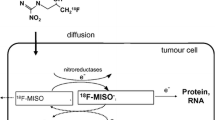Abstract
Purpose
Ferumoxtran-10 belongs to the Ultra Small Particles of Iron Oxide (USPIO) class of contrast agents and induces delayed tumor enhancement in brain tumors, reflecting the trapping of iron oxide particles by the macrophages and activated microglia. The aim of the study was to compare Ferumoxtran-10 contrast enhancement in four human high-grade glioma xenograft models (TCG2, TCG3, TCG4, and U87) with different growing profiles.
Materials and methods
Fragments of human malignant glioma were orthotopically xenografted into the brain of four groups of nude mice. All mice underwent a MRI examination 24 h after intravenous administration of Ferumoxtran-10 (axial T1 SE weighted MR images). The contrast enhancement observed in the different tumor types was measured and was correlated to in vivo tumor growth and to histological parameters, such as proliferative tumor cell fraction, apoptosis, vascular density, and Perls’ staining score.
Results
A good relationship was observed: (a) between tumor-to-background contrast and proliferative index, (b) between tumor-to-background contrast and tumor growth, and (c) between tumor-to-background contrast and Perls’ staining score. The registered MR enhancement contrasts were not influenced by apoptotic index and by vascular density in these experimental xenografts.
Conclusions
Tumor contrast enhancement 24 h after intravenous Ferumoxtran-10 administration seems to be well correlated to tumor proliferative index and tumor growth and could be used as an indirect marker of tumor proliferation.





Similar content being viewed by others
References
Antunes L, Angioi-Duprez K, Bracard S, Klein-Monhoven N, Le Faou A, Duprez A, Plénat F (2000) Analysis of tissue chimerism in nude mouse brain and abdominal xenograft models of human glioblastoma multiforme: what does it tell us about the models and about biology and therapy? J Histochem Cytochem 48:847–858
Bellin M, Roy C, Kinkel K (1998) Lymph node metastases: safety and effectiveness of MR imaging with ultrasmall superparamagnetic iron oxide particles – initial clinical experience. Radiology 207:799–808
Corot C, Petry KG, Trivedi R, Saleh A, Jonkmanns C, Le Bas JF, Blezer E, Rausch M, Brochet B, Foster-Gareau P, Baleriaux D, Gaillard S, Dousset V (2004) Macrophage imaging in central nervous system and in carotid atherosclerotic plaque using ultrasmall superparamagnetic iron oxide in magnetic resonance imaging. Invest Radiol 39:619–625
Dousset V, Delalande C, Ballarino L, Quesson B, Seilhan D, Coussemacq M, Thiaudiere E, Brochet B, Canioni P, Caille JM (1999) In vivo macrophage activity imaging in the central nervous system detected by magnetic resonance. Magn Reson Med 41:329–333
Enochs WS, Harsh G, Hochberg F, Weissleder R (1999) Improved delineation of human brain tumors on MR images using a long-circulating, superparamagnetic iron oxide agent. J Magn Reson Imaging 9:228–232
Fleige G, Nolte C, Synowitz M, Seeberger F, Kettenmann H, Zimmer C (2001) Magnetic labeling of activated microglia in experimental gliomas. Neoplasia 3:489–499
Kleihues P, Cavenee W (2000) Pathology and genetics of tumours of the nervous system. International Agency for Research, Lyon
Muldoon L, Manninger S, Pinkston K, Neuwelt EA (2005) Imaging, distribution, and toxicity of superparamagnetic iron oxide magnetic resonance nanoparticles in the ray brain and intracerebral tumor. Neurosurgery 57:785–796
Neuwelt E, Varallyay P, Bago A, Muldoon L, Nixon R (2004) Imaging of iron oxide nanoparticles by MR and light microscopy in patients with malignant brain tumours. Neuropathol Appl Neurobiol 30:456–471
Pinel S, Barberi-Heyob M, Cohen-Jonathan E, Merlin J, Delmas C, Plenat F, Chastagner P (2004) Erythropoietin-induced reduction of hypoxia before and during fractionated irradiation contributes to improvement of radioresponse in human glioma xenografts. Int J Radiat Oncol Biol Phys 59:250–259
Pinel S, Chastagner P, Merlin J, Marchal C, Taghian A, Barberi-Heyob M (2006) Topotecan can compensate for protracted radiation treatment time effects in high grade glioma xenografts. J Neurooncol 76:31–38
Plénat F, Vignaud J, Guerret-Stocker S, Hartmann D, Duprez K, Duprez A (1992) Host–donor interactions in healing of human split-thickness skin grafts onto nude mice: in situ hybridization, immunohistochemical and histochemical studies. Transplantation 53:1002–1010
Roggendorf W, Strupp S, Paulus W (1996) Distribution and characterization of microglia/macrophages in human brain tumors. Acta Neuropathol 92:288–293
Rosset A, Spadola L, Ratib O (2004) OsiriX: an open-source software for navigating in multidimensional DICOM images. J Digit Imaging 17:205–216
Saini S, Edelman R, Sharma P, Li W, Mayo-Smith W, Slater G, Eisenberg P, Hahn P (1995) Blood-pool MR contrast material for detection and characterisation of focal hepatic lesions: initial clinical experience with ultrasmall superparamagnetic iron oxide (AMI-227). Am J Roentgenol 164:1147–1152
Schroeter M, Saleh A, Wiedermann D, Hoehn M, Jander S (2004) Histochemical detection of ultrasmall superparamagnetic iron oxide (USPIO). Magn Reson Med 52:403–406
Taillandier L, Antunes L, Angioi-Duprez K (2003) Models for neurooncological preclinical studies: solid orthotopic and heterotopic grafts of human gliomas into nude mice. J Neurosci Methods 125:147–157
Varallyay P, Nesbit G, Muldoon L, Nixon R, Delashaw J, Cohen J, Petrillo A, Rink D, Neuwelt E (2002) Comparison of two superparamagnetic viral-sized iron oxide particles Feruxomides and Ferumoxtran-10 with a gadolinium chelate in imaging intracranial tumors. Am J Neuroradiol 23:510–519
Zimmer C, Wright SC, Engelhardt RT, Johnson GA, Kramm C, Breakefield XO, Weissleder R (1997) Tumor cell endocytosis imaging facilitates delineation of the glioma-brain interface. Exp Neurol 143:61–69
Acknowledgements
We thank S. Pizzagalli, D. Muriel, B. Cunin, D. Meng and C. Taine for excellent technical assistance, and C. Maire for expert help in the preparation of this manuscript.
Author information
Authors and Affiliations
Corresponding author
Additional information
Stéphane Kremer and Sophie Pinel have equally contributed to this work.
Rights and permissions
About this article
Cite this article
Kremer, S., Pinel, S., Védrine, PO. et al. Ferumoxtran-10 enhancement in orthotopic xenograft models of human brain tumors: an indirect marker of tumor proliferation?. J Neurooncol 83, 111–119 (2007). https://doi.org/10.1007/s11060-006-9260-8
Received:
Accepted:
Published:
Issue Date:
DOI: https://doi.org/10.1007/s11060-006-9260-8




